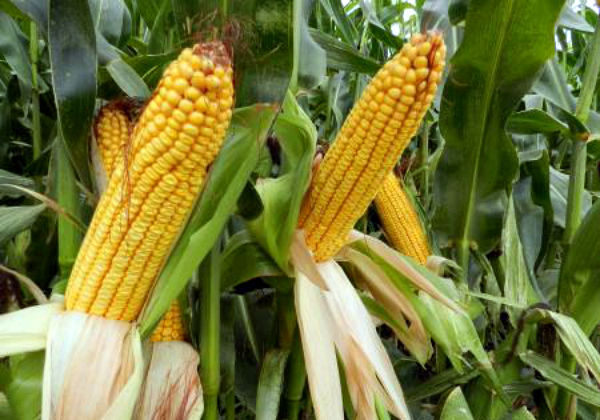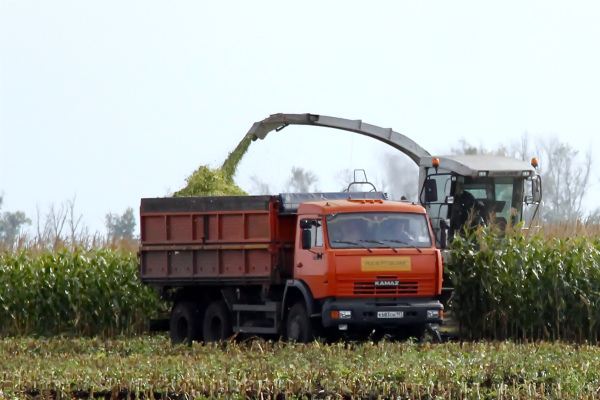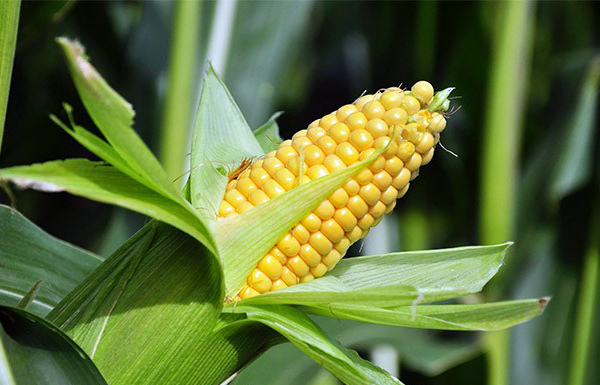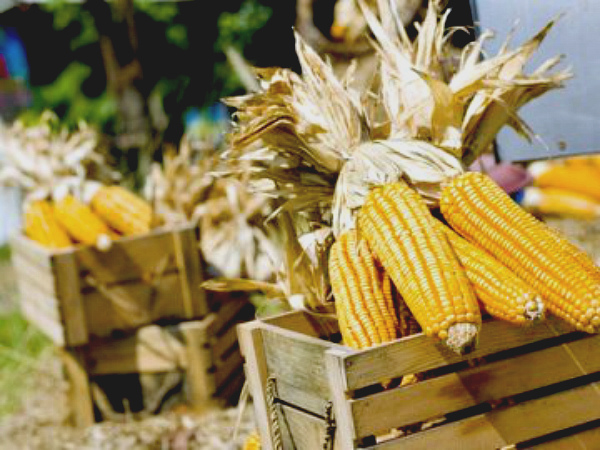When can corn be harvested: ripening time
Types of maize ripeness
In dachas and household plots, this culture is most often grown by those who like to eat tender grains with salt, boiled right on the cob at the end of summer. For this purpose, the harvest is harvested at the stage of milk ripeness. It is at this time that the grain contains the most sugars, the delicate sweet taste is especially loved by children, who often eat grains by biting them from a raw cob. Milky ripeness is characterized by a delicate, very light, almost white grain color. Covering leaves tightly fit the ear, they are difficult to remove, and the hairs are silky and damp, they are brown only at the very base, then a little beige, and at the exit from the ear they are just white. If you press on the grain with your fingernail, then juice may sprinkle - it is so juicy under the thin skin. Such corn is not harvested with a combine.
At the stage of waxy maturity, the inside of the grains is no longer liquid, but not solid either; it can be compared in consistency with soft cheese, which hardens more and more as it ripens. Sugars turn into starch, the delicate milk of the juice becomes just a pulp, when you press on the grain, a dent remains.
Biological maturity occurs somewhat later. The grains have acquired a rich color - yellow or orange, corresponding to the variety. The covering leaves dried up and looked like thin parchment. The hairs are dry and intensely brown. The harvest of such ripeness can already be harvested using a combine.
Cleaning time
Grain corn is harvested at different times depending on the variety, the place of cultivation and the time of sowing. In agricultural production, this is done with the help of special combines, when the dry matter is already at least 60% - this is in the cobs, and in the grain itself after threshing it should be more than 70%. This level of ripeness is checked by evaluating the black layer that appears where the grain is attached to the stem. You should not rush to harvest, but if autumn rains begin, they will reduce the quality of the harvest. And the first frosts will completely spoil it - the grain will simply freeze.
Maize for silage is harvested when there is still a lot of sugar in the grains, when they are wet - at the end of the milky-wax ripeness period. This is the period of the best chemical, physical and quality composition. Silage prepared after harvesting the milky-wax ripeness is the most nutritious.
But here it is important to determine the right timing - it is best to harvest at the stage of wax ripeness. At the beginning of the period of milky-wax ripeness, the grains contain too much liquid, the loss of 5% of dry mass is fraught with rapid oxidation, which is not desirable for silage. And when the corn has already reached waxy ripeness, the grains are still wet (up to 70%), but the sugar has not yet turned into starch. Silage made from harvested too early will not be of good quality, because the necessary nutrients will be lacking in it. This is very important, because the amount of food that needs to be prepared for animals depends on the quality of food.
If corn is harvested with a combine harvester at the stage of grain waxy maturity, then silage will give the animals 20% more energy, that is, just as much less concentrated feed can be prepared.
In dachas and personal plots for food or preservation of delicate grains, the harvest is harvested when the grains have reached milk ripeness, since at this time they are the sweetest and most tender. Neither harvesters nor any devices are used here except the gentle hands of the owner. It is impossible to determine the exact timing of collection, you can only check from time to time the degree of maturity simply by hand.
It is necessary to check by touch whether the grains have swollen along the entire length of the cob. In a ripe ear, the end becomes elastic and rounded, in an immature ear, it is sharp. The silky hair of mature cobs is dry and brown. They say that it is at the peak of maturity that the grains have the highest concentration of sugars and all nutrients.
If you do not understand anything by touch, you can slightly bend the covering leaves and look at the grains. They should no longer be white, but the delicate creamy color should not gain its bright intensity. You can pierce a grain with a fingernail and look at the juice - if it is completely transparent, then pick it up early, if it has turned into an ordinary pulp - the moment of the best taste has already been missed.
If it is too early to harvest, then after inspecting the cob, the covering leaves must be returned to their place, otherwise the birds will eat your crop.
The cobs never pick them all at once. It is known that the uppermost ones ripen first, they tilt from the stem. As soon as the top ear is almost perpendicular to the stem, it's time to check its ripeness. It is advisable to pay attention to the 2021 lunar calendar for summer cottages.
For livestock feed from household plots, corn is harvested when it reaches biological maturity, otherwise it will be difficult to preserve it in winter. The kernels are stored on the cob if there is sufficient space.
How to collect
Silage corn at a height of 20 cm is cut with a special harvester, a PNP-2.4 device is attached to it, and another one is attached to it, which collects swaths and crushes the plants. Agricultural enterprises always use machinery for harvesting. For grain, corn is harvested by combines together with special corn headers. If you use only combines, the quality of harvesting will be worse, and the loss of product will be greater. Plants are cut 15 cm above the ground.
At your dacha, you are your own harvester and reaper. After waiting for the moment of milky ripeness of the upper ears, they need to be removed with your hands - they just grab the stalk with one hand, and unscrew the ear from it with the other. Each plant usually has more than two (especially on hybrids) ears, and so, the lower ones can ripen 10 days later than the upper ones. It is worth keeping at hand the lunar sowing calendar for the fall of 2021 and referring to it.
Milk corn is not stored for a long time; it must be eaten immediately or kept for a little (up to 1 week) in the refrigerator. She will lose sweetness all the time, but the cold will slightly delay the conversion of sugar into starch.
Popcorn corn is harvested in the same way. Breaking off the ear from the stem will be even easier - since this happens much later, the stems and leaves should dry out. After that, the grains are dried and dried for more than a month. Do this in a warm room with adequate ventilation. After the drying stage, the cobs are stored in a cellar or similar room, and the grains are simply stored in a tightly closed jar on the shelf of the kitchen cabinet.
The seed corn is harvested a month after the tender and sweet corn has been harvested for eating. By this time, the leaves were completely dry, the trunk darkened. The ears are torn off the stem by hand, turning slightly in different directions. Then the grains are dried by removing the integumentary leaves. Well dried, they easily crumble from the cob if you take it with both hands and rub it in opposite directions.Store them in a hermetically sealed container, the place for it should be dark, dry and cool. After proper collection and drying, they will not lose germination for up to 10 years.
Video Harvesting Corn in the USA
This video shows Iowa farmers harvesting massive corn crops.






